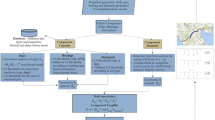Abstract
This study focusses on the estimation of seismic fragility curves for all common bridge types found in modern greek motorways. At first a classification scheme is developed in order to classify the existing bridges into a sufficient number of classes. A total of 11 representative bridge classes resulted, based on the type of piers, deck, and pier-to-deck connection. Then an analytical methodology for deriving fragility curves is proposed and applied to the representative bridge models. This procedure is based on pushover analysis of the entire bridge and definition of damage states in terms of parameters of the bridge pushover curves. The procedure differentiates the way of defining damage according to the seismic energy dissipation mechanism in each bridge, i.e. bridges with yielding piers of the column type and bridges with bearings (with or without seismic links) and non-yielding piers of the wall type. The activation of the abutment-backfill system due to closure of the gap between the deck and the abutments is also taken into account. The derived fragility curves are subjected to a first calibration against empirical curves based on damage data from the US and Japan.
Similar content being viewed by others
References
Applied Technology Council [ATC] (1985) Earthquake damage evaluation data for California. Report ATC-13, Applied Technology Council, Redwood City, CA
ATC (1996) Seismic evaluation and retrofit of concrete buildings. Rep. No. SSC 96–01: ATC-40, 1, Redwood City, CA
Athanassiadou C, Karakostas C, Kappos AJ, Lekidis V (2004) Inelastic strength and displacement design spectra based on greek earthquake records. In: 13th world conference on earthquake engineering. Vancouver, CD ROM Proceedings, Paper no. 2519
Basöz NI, Kiremidjian AS, King SA, Law KH (1999) Statistical analysis of bridge damage data from the 1994 Northridge, CA, earthquake. Earthquake Spectra 15(1): 25–54
Cardone D, Perrone G, Dolce M (2007) Seismic risk assessment of highway bridges. In: Proceedings 1st US–Italy seismic bridge workshop. IUSS Press Ltd, Pavia (Italy)
Choi E, DesRoches R, Nielson B (2004) Seismic fragility of typical bridges in moderate seismic zones. Eng Struct 26(2): 187–199
Computers and Structures Inc (2005) SAP2000: linear and non linear static and dynamic analysis and design of three-dimensional structures. Berkeley, California
Dutta A, Mander JB (1998) Seismic fragility analysis of highway bridges, INCEDE-MCEER center-to-center. In: Proceedings of the center-to-center workshop on earthquake engineering frontiers in transport systems, Tokyo, Japan, pp 311–325
EQE International (2000) Seismic risk assessment tool: specification document. Prepared for Egnatia Odos A.E. Report no. 460-01-RS-01, Issue 1
Erduran E, Yakut A (2004) Drift based damage functions for reinforced concrete columns. Comput Struct 82(2–3): 121–130
Fajfar P (1999) Capacity spectrum method based on inelastic demand spectra. Earthquake Eng Struct Dyn 28(9): 979–993
FEMA-NIBS (2004) Multi-hazard loss estimation methodology—earthquake model: HAZUS®MH Technical Manual, Washington, DC
FHWA [Federal Highway Administration] (1995) Recording and coding guide for the structure inventory and appraisal of the nation’s bridges. Rep. no. FHWA-PD-96-001, Office of Engineering, Bridge Division, Washington, DC
Gardoni P, Khalid MM, Kiureghian AD (2003) Probabilistic seismic demand models and fragility estimates for RC bridges. J Earthquake Eng 7(1): 79–106
Hwang H, Jernigan JB, Lin YW (2000) Evaluation of seismic damage to memphis bridges and highway systems. J Bridg Eng ASCE 5(4): 322–330
Kappos AJ, Moschonas IF, Paraskeva T, Sextos AG (2006) A methodology for derivation of fragility curves for bridges with the aid of advanced analysis tools. In: 1st European conference on earthquake engineering and seismology, Geneva, Switzerland, Paper no. 275
Kappos AJ, Potikas P, Sextos AG (2007) Seismic assessment of an overpass bridge accounting for non- linear material and soil response and varying boundary conditions. In: Proceedings of the conference on computational methods in structural dynamics and earthquake engineering (COMPDYN), Rethymno, Greece, Paper no. 1580
Karakostas CZ, Athanassiadou CJ, Kappos AJ, Lekidis VA (2007) Site-dependent design spectra and strength modification factors, based on records from Greece. Soil Dyn Earthquake Eng 27(11): 1012–1027
Karim KR, Yamazaki F (2001) Effect of earthquake ground motions on fragility curves of highway bridge piers based on numerical simulation. Earthquake Eng Struct Dyn 30(12): 1839–1856
Lupoi A, Franchin P, Pinto PE, Monti G (2005) Seismic design of bridges accounting for spatial variability of ground motion. Earthquake Eng Struct Dyn 34(4–5): 327–348
Mackie KR, Stojadinovic B (2007) R-factor parameterized bridge damage fragility curves. J Bridg Eng ASCE 12(4): 500–510
Mander JB, Basöz N (1999) Seismic fragility curve theory for highway bridges. In: Proceedings of the 5th US conference on lifeline earthquake engineering, TCLEE No. 16, ASCE, 1999, pp 31–40
Monti G, Nistico N (2002) Simple probability-based assessment of bridges under scenario earthquakes. J Bridg Eng ASCE 7(2): 104–114
Paraskeva T, Kappos A (2007) Seismic assessment of an over-cross bridge using modal pushover analysis and dynamic time-history analysis. In: Proceedings of the conference on computational methods in structural dynamics and earthquake engineering (COMPDYN), Rethymno, Greece, Paper no. 1376
Paraskeva T, Kappos A, Sextos A (2006) Extension of modal pushover analysis to seismic assessment of bridges. Earthquake Eng Struct Dyn 35(10): 1269–1293
SETRA [Service d’ Etudes Techniques des Routes et Autoroutes] (1998) Typologie IQOA—Valise de formation IQOA Ponts. Ministère de l’ Equipement, des Transports, etc, France
Sextos A, Pitilakis K, Kappos A (2003) Inelastic dynamic analysis of RC bridges accounting for spatial variability of ground motion, site effects and soil–structure interaction phenomena. Part 1: methodology and analytical tools. Earthquake Eng Struct Dyn 32(4): 602–627
Shinozuka M, Feng MQ, Kim HK, Kim SH (2000) Nonlinear static procedure for fragility curve development. J Eng Mech ASCE 126(12): 1287–1295
Author information
Authors and Affiliations
Corresponding author
Rights and permissions
About this article
Cite this article
Moschonas, I.F., Kappos, A.J., Panetsos, P. et al. Seismic fragility curves for greek bridges: methodology and case studies. Bull Earthquake Eng 7, 439–468 (2009). https://doi.org/10.1007/s10518-008-9077-2
Received:
Accepted:
Published:
Issue Date:
DOI: https://doi.org/10.1007/s10518-008-9077-2




